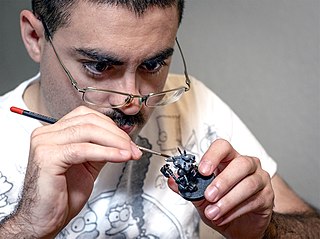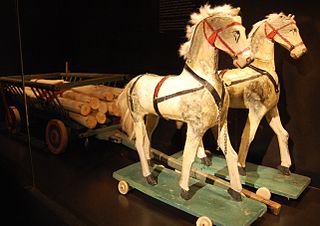
A wargame is a strategy game in which two or more players command opposing armed forces in a simulation of an armed conflict. Wargaming may be played for recreation, to train military officers in the art of strategic thinking, or to study the nature of potential conflicts. Many wargames re-create specific historic battles, and can cover either whole wars, or any campaigns, battles, or lower-level engagements within them. Many simulate land combat, but there are wargames for naval, air combat, and cyber as well as many that combine various domains.

Miniature wargaming is a form of wargaming in which military units are represented by miniature physical models on a model battlefield. Miniature wargames are played using model soldiers, vehicles, and artillery on a model battlefield, with the primary appeal being recreational rather than functional. Miniature wargames are played on custom-made battlefields, often with modular terrain, and abstract scaling is used to adapt real-world ranges to the limitations of table space. The use of physical models to represent military units is in contrast to other tabletop wargames that use abstract pieces such as counters or blocks, or computer wargames which use virtual models. The primary benefit of using models is immersion, though in certain wargames the size and shape of the models can have practical consequences on how the match plays out. Models' dimensions and positioning are crucial for measuring distances during gameplay. Issues concerning scale and accuracy compromise realism too much for most serious military applications.

In miniature wargaming, players enact simulated battles using scale models called miniature models, which can be anywhere from 2 to 54 mm in height, to represent warriors, vehicles, artillery, buildings, and terrain. These models are colloquially referred to as miniatures or minis.

Military miniaturism is a niche within the broader hobby of modeling focusing on military subjects. It is itself a rather broad subject, dealing with any scale model of military theme. It has an ever growing range of sub-hobbies, including scale figure modeling, armour modeling, model ship building, military aviation modeling, and historical wargaming.

Figure painting, or miniature painting, is the hobby of painting miniature figures and/or model figures, either as a standalone activity or as a part of another activity that uses models, such as role-playing games, wargames, or military modeling.

Warmaster is a ruleset for tabletop wargames written by Rick Priestley, published by Specialist Games, and set in the Warhammer Fantasy setting. It is different from Warhammer Fantasy Battles in both appearance and gameplay. It is intended for 10 –12 mm miniatures. Basic troops are based on stands, of which typically three make a unit. Generals, Heroes and Wizards are mounted individually or with their retinue.
Inquisitor was a tabletop miniatures game based in Games Workshop's Warhammer 40,000 universe. Whereas the main line of Warhammer 40K games is based on squad based tactical warfare, Inquisitor focused on a small group of player characters akin to many role-playing games. Inquisitor miniatures are no longer produced by Games Workshop but, whilst they were, the game had its own website and 54 mm scale models were available as "Specialist Games" from the Games Workshop catalogue.

Citadel Miniatures Limited is a company which produces metal, resin and plastic miniature figures for tabletop wargames such as Warhammer Fantasy Battle and Warhammer 40,000.

Middle Earth Strategy Battle Game, previously marketed as The Lord of the Rings Strategy Battle Game, The Hobbit: An Unexpected Journey Strategy Battle Game, The Hobbit: The Desolation of Smaug Strategy Battle Game and The Hobbit: The Battle of Five Armies Strategy Battle Game, is a tabletop miniature wargame produced by Games Workshop. It is based on The Lord of the Rings and The Hobbit film trilogies directed by Peter Jackson, and the books that inspired them, written by J. R. R. Tolkien.
A garage kit (ガレージキット) or resin kit is an assembly scale model kit most commonly cast in polyurethane resin.
1:144 scale is a scale used for some scale models such as micro/mini armor. 1:144 means that the dimensions of the model are 1/144 (0.00694) the dimensions of the original life-sized object; this equates to a scale of 1/2 inch per 6 feet of original dimension. For instance, an airplane 30 feet (9.14 m) in length would be a mere 2.5 inches (63.5 mm) long as a 1:144 scale model.
Grenadier Models Inc. of Springfield, Pennsylvania produced lead miniature figures for wargames and role-playing games with fantasy, science fiction and heroic themes between 1975 and 1996. Grenadier Models Inc. is best known for their figures for TSR, Inc.'s Advanced Dungeons & Dragons game, collectible Dragon-of-the-Month and Giants Club figures, and their marketing of paint and miniature sets through traditional retail outlets.

Warhammer Ancient Battles is a ruleset for miniatures wargames produced by Games Workshop's Warhammer Historical Wargames imprint. It is a rulebook for historical wargames developed from the popular Warhammer Fantasy Battle by Jervis Johnson, Rick Priestley and the Perry brothers. On 24 May 2012, Warhammer Historical closed their website and are now defunct.

Model horses are scale replicas of real horses. They originated simultaneously – but independently – in the United States, Canada, and the United Kingdom, followed later by Sweden (UK-influenced), Germany (US-influenced), and Australia. They encompass a wide variety of fanbase activities, from those who simply like to collect, to those who show their models at model horse shows. Unlike model cars or trains, model horse collectibles do not need to be assembled from kits, although they can be altered to the collector's liking.

Alan and Michael Perry are former Citadel Miniatures designers, and two of the most renowned and prolific sculptors for the miniature wargaming hobby. They worked for Games Workshop from 1978 until 2014, and during that time worked on most of the company's miniature ranges.
Pinning is a technique used when assembling large or heavy model kits that involves drilling a hole in two pieces of the model to be joined, and using a "pin" to strengthen the bond when they are glued. Pinning is a useful technique for reinforcing joints and is essential when making models from parts that were not designed to go together, such as a miniature conversion.
Formed in 1975, Ral Partha Enterprises, Inc. of Cincinnati, Ohio, United States, is now known as Ral Partha Legacy Ltd. and produces miniature figures in 25 mm, 30 mm, 15 mm, and 54 mm scale. The company's products are made by spin-casting metal alloys which depict soldiers, adventurers and creatures that have been inspired by history and fiction. Their miniatures are sold at gaming conventions, in hobby shops, and by internet and mail order for use in role playing games, wargaming, dioramas, competitive painting, and collecting.

Epoxy putty refers to a group of room-temperature-hardening substances used as space-filling adhesives. Exact compositions vary according to manufacturer and application. They are stored until used as two components of clay-like consistency. Kneading the two components into each other creates an exothermic chemical reaction that activates the substance for use by catalysing an epoxide polymerisation reaction. Unlike many other types of glues, an epoxy adhesive can fill gaps, and even be moulded into a structural part. Some makers claim in advertising that one can drill and tap their cured products and that they quickly cure "hard as steel", though they are much weaker than steel in tensile strength and shear strength.
Wargames Factory was an American plastic miniature manufacturer that opened in 2007. It specialized in highly detailed, multi-part models in hard plastic for wargaming. Wargames Factory produced models mostly in the 28 millimetres (1.1 in) range, but did other scales as well. It was unique in the way it chose the subject of its miniatures, using what it called the Liberty and Union League to produce models submitted by consumers.

Der Kriegspielers Fantastiques was a line of fantasy miniature figures that were produced by Custom Cast and then Heritage Models beginning in the 1970s.













